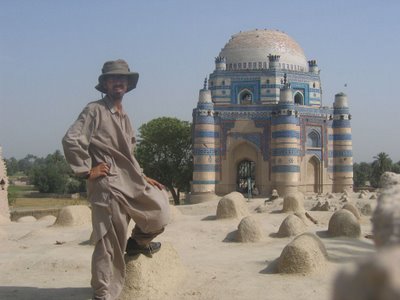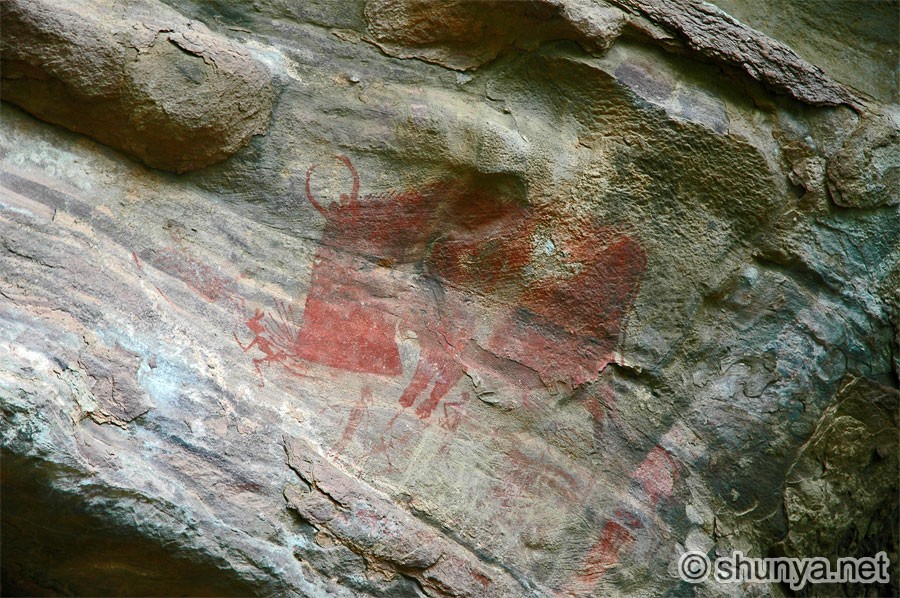For those of you afraid of another lame Hollywood movie tie-in don't worry, Swat is actually the name of a popular valley in Pakistan's Northwest Frontier Province. It is here that many Pakistanis come to cool down in the Summer months, but for me it's still too low and therefore too hot. But before I leave I decided to investigate to see what the area had to offer.
Swat's history goes way back to the time of Alexander the Great who came tearing through the valley on his conquests, carrying out sieges and battles along the way, the traces of which are still visible to this day. A large number of his followers stayed and so when Buddhism came through, this time a tad more peacefully, it was taken up by them, so it is possible to see old ruined stupas with Graecian columns and little cupids on the lintels; certainly not something you expect to find this far east. So I have been pottering about, wandering from ruins to ruins, taking in the cleaner air (once you get away from the towns and their two-stroke rickshaws, that is) and enjoying the more verdant countryside (green fields, orchards and verges choked with some sort of hemp-like plant that the locals seem to like and call bhang) with walks up nearby mountains. Apropos of which, I continue to be convinced of the fact that I sweat more than anybody else alive. On one excursion up a mountain once I had reached the top and sat down for a while, my clothes began to acquire a multitude of white streaks. Upon closer inspection it was the salt from my evaporated sweat. The patterns were actually quite fetching and would probably make quite a stir on the catwalk, but I'd rather sweat less and not have to carry so much water around with me (a little mundane and useless fact for those of you who prefer less political diatribe and history with your blogs).
The place is OK. The ruins not bad. The views modest. Nothing to rave about ... except for the people. Around every corner is a new encounter and another offer of conversation, chai and often lunch. One fine example of Pakistani hospitality occurred two days ago. I had just finished a hike and arrived in a small town to try and find some lunch. I found a shop that sold some snacks and inquired about a restaurant or hotel. An old man sitting close by motioned to me and said roti (meaning bread) to which I nodded my head. He motioned to me to follow him as he led me to his nearby shoe-repair boutique. A bit of a misnomer, I might add, as it was little more than a hole in the wall with barely enough room to squeeze in a cat, let alone swing one. I was told to sit down and off he trundled. After 10 minutes I was beginning to get rather anxious despite being entertained by the local children (or entertaining them with my digital camera). But then he reappeared carrying a tray containing not only bread, but also three various dishes as well as salad. He laid it all out in front of me and watched contentedly as I sheepishly started on the banquet, when all I had really wanted was a little something to tide me over to dinner. Of course I couldn't handle even half of it and he wouldn't hear of letting me pay for any of it although it could easily have cost him more than half a day's wage. That sort of story, however, isn't deemed newsworthy, instead all we hear about Pakistan is Taliban this and Taliban that, or another bombing. Another man who invited me in for dinner told me that "hospitality is our heritage", and an impeccable one it is too, and one we could do well by trying to emulate.
Swat's history goes way back to the time of Alexander the Great who came tearing through the valley on his conquests, carrying out sieges and battles along the way, the traces of which are still visible to this day. A large number of his followers stayed and so when Buddhism came through, this time a tad more peacefully, it was taken up by them, so it is possible to see old ruined stupas with Graecian columns and little cupids on the lintels; certainly not something you expect to find this far east. So I have been pottering about, wandering from ruins to ruins, taking in the cleaner air (once you get away from the towns and their two-stroke rickshaws, that is) and enjoying the more verdant countryside (green fields, orchards and verges choked with some sort of hemp-like plant that the locals seem to like and call bhang) with walks up nearby mountains. Apropos of which, I continue to be convinced of the fact that I sweat more than anybody else alive. On one excursion up a mountain once I had reached the top and sat down for a while, my clothes began to acquire a multitude of white streaks. Upon closer inspection it was the salt from my evaporated sweat. The patterns were actually quite fetching and would probably make quite a stir on the catwalk, but I'd rather sweat less and not have to carry so much water around with me (a little mundane and useless fact for those of you who prefer less political diatribe and history with your blogs).
The place is OK. The ruins not bad. The views modest. Nothing to rave about ... except for the people. Around every corner is a new encounter and another offer of conversation, chai and often lunch. One fine example of Pakistani hospitality occurred two days ago. I had just finished a hike and arrived in a small town to try and find some lunch. I found a shop that sold some snacks and inquired about a restaurant or hotel. An old man sitting close by motioned to me and said roti (meaning bread) to which I nodded my head. He motioned to me to follow him as he led me to his nearby shoe-repair boutique. A bit of a misnomer, I might add, as it was little more than a hole in the wall with barely enough room to squeeze in a cat, let alone swing one. I was told to sit down and off he trundled. After 10 minutes I was beginning to get rather anxious despite being entertained by the local children (or entertaining them with my digital camera). But then he reappeared carrying a tray containing not only bread, but also three various dishes as well as salad. He laid it all out in front of me and watched contentedly as I sheepishly started on the banquet, when all I had really wanted was a little something to tide me over to dinner. Of course I couldn't handle even half of it and he wouldn't hear of letting me pay for any of it although it could easily have cost him more than half a day's wage. That sort of story, however, isn't deemed newsworthy, instead all we hear about Pakistan is Taliban this and Taliban that, or another bombing. Another man who invited me in for dinner told me that "hospitality is our heritage", and an impeccable one it is too, and one we could do well by trying to emulate.





